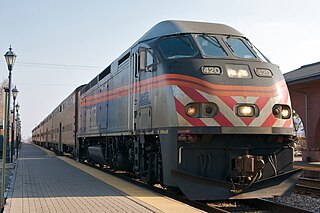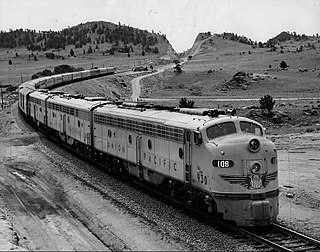
The Chicago, Milwaukee, St. Paul and Pacific Railroad (CMStP&P), better known as the Milwaukee Road, was a Class I railroad that operated in the Midwest and Northwest of the United States from 1847 until 1986.

The Hiawatha Service, or simply Hiawatha, is an 86-mile (138 km) train route operated by Amtrak on the western shore of Lake Michigan between Chicago, Illinois, and Milwaukee, Wisconsin. However, the name was historically applied to several different routes that extended across the Midwest and to the Pacific Ocean. As of 2007, twelve to fourteen trains ran daily between Chicago and Milwaukee, making intermediate stops in Glenview, Illinois; Sturtevant, Wisconsin; and Milwaukee Mitchell International Airport. The line is partially supported by funds from the state governments of Wisconsin and Illinois. The line utilizes the CPKC Railway's C&M Subdivision and Metra's Milwaukee District North Line.

Saint Paul Union Depot is a historic railroad station and intermodal transit hub in the Lowertown neighborhood of Saint Paul, Minnesota. It serves light rail, intercity rail, intercity bus, and local bus services.

The Hiawathas were a fleet of named passenger trains operated by the Chicago, Milwaukee, St. Paul and Pacific Railroad between Chicago and various destinations in the Midwest and Western United States. The most notable of these trains was the original Twin Cities Hiawatha, which served the Twin Cities in Minnesota. The train was named for the epic poem The Song of Hiawatha by Henry Wadsworth Longfellow.

The North Coast Hiawatha was a long-distance passenger train operated by Amtrak between Chicago, Illinois, and Seattle, Washington.

The Milwaukee District West Line (MD-W) is a Metra commuter rail line in Chicago, Illinois, and its western suburbs. Metra does not refer to any of its lines by a particular color, but the timetable accents for the Milwaukee District West line are dark "Arrow Yellow," honoring the Milwaukee Road's Arrow passenger train. Trains are dispatched from the Canadian Pacific Kansas City Railway's American headquarters in Minneapolis.

The Olympian and its successor the Olympian Hiawatha were passenger trains operated by the Chicago, Milwaukee, St. Paul and Pacific Railroad between Chicago and the Pacific Northwest. The Olympian operated from 1911 to 1947 and was, along with its running mate the Columbian, the first all-steel train to operate in the Pacific Northwest. The streamlined Olympian Hiawatha operated from 1947 to 1961 and was one of several Milwaukee Road trains to carry the name "Hiawatha". The Olympian Hiawatha was designed by industrial designer Brooks Stevens and included the distinctive glassed-in "Skytop" observation-sleeping cars. It later featured full-length "Super Dome" cars.

The Kansas City Zephyr was a streamliner passenger train service operated by the Chicago, Burlington and Quincy Railroad (CB&Q) between Chicago and Kansas City.

The Challengers were named passenger trains on the Union Pacific Railroad and the Chicago and North Western Railway. The economy service ran between Chicago, Illinois, and the West Coast of the United States. The trains had full Pullman service and coach seating and were an attempt to draw Depression-Era riders back to the rails. Food service was advertised as "three meals for under a dollar a day."

Milwaukee Intermodal Station is an intercity bus and train station in downtown Milwaukee, Wisconsin. Amtrak service at Milwaukee includes the daily Empire Builder, the daily Borealis, and the six daily Hiawatha Service round trips. It is Amtrak's 18th-busiest station nationwide, and the second-busiest in the Midwest, behind only Chicago Union Station. The station is served by bus companies Coach USA - Wisconsin Coach Lines, Greyhound Lines, Jefferson Lines, Indian Trails, Lamers, Badger Bus, Tornado Bus Company, and Megabus. It is also the western terminus of the M-Line service of The Hop streetcar.

La Crosse station is an Amtrak intercity train station in La Crosse, Wisconsin, served by the daily Borealis and Empire Builder. The station was built in 1926–27 by the Chicago, Milwaukee, St. Paul, and Pacific Railroad, replacing an older station that burned in 1916. The station was listed on the National Register of Historic Places as the Chicago, Milwaukee and St. Paul Railway Depot and was renovated in 2001.

The Twin Cities Hiawatha, often just Hiawatha, was a named passenger train operated by the Chicago, Milwaukee, St. Paul and Pacific Railroad, and traveled from Chicago to the Twin Cities. The original train takes its name from the epic poem The Song of Hiawatha by Henry Wadsworth Longfellow. There are a number of Hiawatha-themed names within the city of Minneapolis, the terminus of the original train. The first Hiawatha ran in 1935; in 1939 the Milwaukee Road introduced a second daily trip between Chicago and Minneapolis. The two trains were known as the Morning Hiawatha and Afternoon Hiawatha, or sometimes the AM Twin Cities Hiawatha and PM Twin Cities Hiawatha. The Milwaukee Road discontinued the Afternoon Hiawatha in 1970 while the Morning Hiawatha continued running until the formation of Amtrak in 1971.

The Watertown Subdivision or Watertown Sub is a 92.7-mile (149.2 km) railway line in Wisconsin operated by Canadian Pacific Kansas City (CPKC) through its primary United States subsidiary, the Soo Line Railroad. It meets CPKC's Tomah Subdivision in the west in Portage and runs to Milwaukee in the east where it meets the C&M Subdivision. The Watertown Subdivision had previously been operated by the Chicago, Milwaukee, St. Paul and Pacific Railroad, though the Soo Line Railroad took it over when the Milwaukee Road folded. Canadian Pacific gained ownership via taking over the Soo Line. CP consolidated its operations with the Kansas City Southern Railway on April 14, 2023 to form CPKC.

SEMTA Commuter Rail, also known as the Silver Streak, was a commuter train operated by the Southeastern Michigan Transportation Authority (SEMTA) and the Grand Trunk Western Railroad between Detroit and Pontiac, Michigan. It began in 1974 when SEMTA assumed control of the Grand Trunk's existing commuter trains over the route. SEMTA discontinued operations in 1983. Amtrak began offering intercity service between Detroit and Pontiac in 1994 as part of its Michigan Services.

The Varsity was a passenger train operated by the Chicago, Milwaukee, St. Paul & Pacific Railroad over a 140-mile route between Chicago and Madison, Wisconsin.
The El Camino was a set of lightweight streamlined railcars owned by Los Angeles County in the 1970s and 1980s. The county acquired the cars to bootstrap a proposed commuter rail service between Los Angeles and Orange County. This effort, spearheaded by County Supervisor Baxter Ward, was unsuccessful. The equipment saw limited use on Amtrak's San Diegan in 1978 and was sold in 1985.

The Milwaukee Road Depot in Oconomowoc, Wisconsin, United States, is a railroad depot built in 1896 and operated by the Chicago, Milwaukee, St. Paul and Pacific Railroad. It is a one-story hip-roofed building clad in split granite. The station served the Twin Cities Hiawatha from its formation in 1935 to its discontinuation in 1971, and now operates as Maxim's Restaurant. On display outside is a railway platform and Northern Pacific Railway 1923, a passenger car that operated on the Kettle Moraine Scenic Railway which was later renovated and painted red. The Canadian Pacific Railway's single-tracked Watertown Subdivision remains next to the depot.

The Borealis, referred to as Twin Cities–Milwaukee–Chicago (TCMC) during planning, is an Amtrak inter-city rail service that operates daily between Chicago, Illinois, and Saint Paul, Minnesota, via Milwaukee, Wisconsin. The first service began on May 21, 2024, under the Amtrak Midwest brand.

Lake Geneva station was an Amtrak intercity rail station in Zenda, Wisconsin. Commuter service to Zenda was operated by the Milwaukee Road from 1900 to 1982. Lake Geneva station was added as an infill station on the Lake Country Limited on June 15, 2000, to serve the Lake Geneva resort area. The Lake Country Limited was never successful, and service ended on September 23, 2001. Commuter service with a stop near Zenda was studied in 2001, but found to only be marginally feasible.

Amtrak Midwest is a brand name applied by Amtrak to its state-supported routes in the Midwest states of Illinois, Michigan, Wisconsin, Minnesota, and Missouri. As of May 2024, Amtrak Midwest consists of eleven named trains:




















